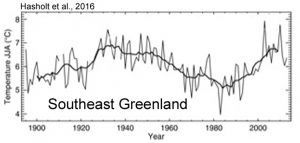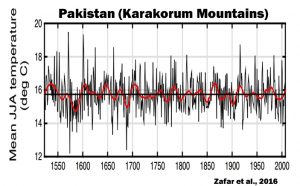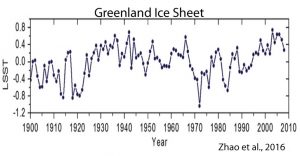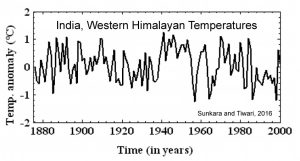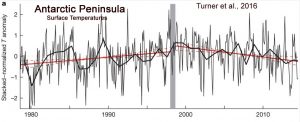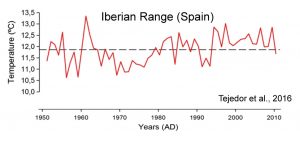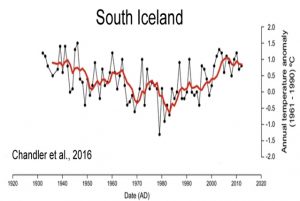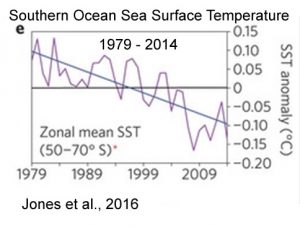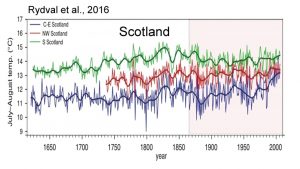
Two fundamental tenets of the anthropogenic global warming narrative are (1) the globe is warming (i.e., it’s not just regional warming), and (2) the warming that has occurred since 1950 can be characterized as remarkable, unnatural, and largely unprecedented. In other words, today’s climate is substantially and alarmingly different than what has occurred in the past….because the human impact has been profound.
Well, maybe. Scientists are increasingly finding that the two fundamental points cited above may not be supported by the evidence.
In 2016, an examination of the peer-reviewed scientific literature has uncovered dozens of paleoclimate reconstructions that reveal modern “global” warming has not actually been global in scale after all, as there are a large number of regions on the globe where it has been cooling for decades. Even if it was warming on a global scale, the paleoclimate evidence strongly suggests that the modern warm climate is neither unusual or profoundly different than it has been in the past. In fact, today’s regional warmth isn’t even close to approaching the Earth’s maximum temperatures achieved earlier in the Holocene, or as recently as 1,000 years ago (the Medieval Warm Period), when anthropogenic CO2 emissions could not have exerted a climate impact.
In fact, there is a growing body of evidence that the warming in recent decades is not even unprecedented within the context of the last 80 years. That’s because the amplitude of the 1930s and 1940s warm period matched or exceeded that of the warmth in the late 20th and early 21st centuries in many regions of the world. Furthermore, between the warmth of the 1930s and ’40s and the warmth of the 1990s to present, there was a very widely publicized cooling period (late 1950s to early 1970s) that was heavily discussed in the peer-reviewed scientific literature.
Today’s instrumental datasets curiously do not reflect this 20th century warming-cooling-warming oscillatory shape, however, as doing so would not lend support to the modeled understanding that climate is shaped by anthropogenic CO2 emissions, which have increased linearly, not cyclically. In fact, not only has the high amplitude of the 1930s and 1940s warmth been “adjusted” down or depressed in global-scale representations of instrumental temperatures by NASA or the MetOffice, the substantial cooling (-0.5°C in the Northern Hemisphere, including -1.5°C cooling in the Arctic region) that occurred in the 1960s and 1970s has all but disappeared from today’s temperature graphs.
Scientists, meanwhile, keep on publishing their results. And their results don’t lend support to the narrative that the globe has been synchronously warming, or warming in linear fashion and in concert with the rise in anthropogenic CO2 emissions. Indeed, in many regions of the world, decadal-scale cooling has occurred since the mid-20th century.
Listed below are a collection of 50 peer-reviewed scientific papers published within the last year (2016) undermining the “consensus” position that modern warming patterns are global in extent and synchronization, and that today’s warmth is both unusual and unprecedented. The first section (1) identifies the regions of the world where there has been no net warming in recent decades. The second section (2) puts modern climate into its much larger Holocene context, revealing just how insignificant and unremarkable this current (regional) warming trend has been relative to history.
(1) ‘Global’ Warming? No Net Warming In These Regions Since Mid Or Late 20th Century
De Jong et al., 2016 (Andes, South America)
[T]he reconstruction…shows that recent warming (until AD 2009) is not exceptional in the context of the past century. For example, the periods around AD 1940 and from AD 1950–1955 were warmer. This is also shown in the reanalysis data for this region and was also observed by Neukom et al. (2010b) and Neukom and Gergis (2011) for Patagonia and central Chile. Similarly, based on tree ring analyses from the upper tree limit in northern Patagonia, Villalba et al. (2003) found that the period just before AD 1950 was substantially warmer than more recent decades.
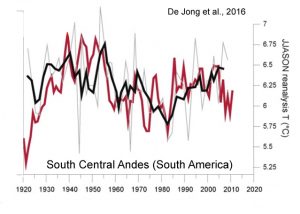
Zhu et al., 2016 (China)
[W]e should point out that the rapid warming during the 20th century was not especially obvious in our reconstructed RLST.
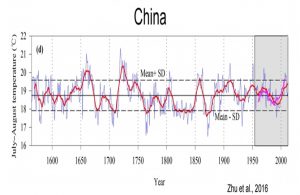
Zhang et al., 2016 (Scandinavia)
[P]resent-day global mean air temperatures may have been equally high around 1000 years ago during the so-called Medieval Climate Anomaly (MCA; Lamb, 1969; Grove and Switsur, 1994). However, since regional temperature reconstructions display large variability in the timing and magnitude of the MCA (PAGES 2k Consortium, 2013), this issue has not yet been adequately settled. Hence, there is still a great need to produce and improve empirical proxy data to further our understanding of near and distant climate changes.
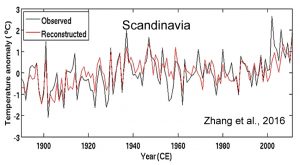
Zafar et al., 2016 (Pakistan, Karakorum Mountains)
[O]ur results indicate that Karakorum temperature has remained decidedly out of phase with hemispheric temperature trends for at the least the past five centuries
Zhao et al., 2016 (Greenland Ice Sheet)
Sunkara and Tiwari, 2016 (India, Western Himalayas)
Turner et al., 2016 (Antarctic Peninsula)
Absence of 21st century warming on Antarctic Peninsula consistent with natural variability
Tejedor et al., 2016 (Iberian Range, Spain)
Chandler et al., 2016 (South Iceland)
Analysis of climate data for SE Iceland also indicates that the three periods of ice-frontal retreat [1936-’41, 1951-’56, and 2006-’11] identified are associated with similar summer air temperature values, which has previously been shown to be a key control in terminus variations in Iceland. We, therefore, demonstrated that the coincidence of the most recent phase of ice-frontal retreat at Skálafellsjökull (2006–2011) and warming summer temperatures is not unusual in the context of the last ~80 years. This highlights the need to place observations of contemporary glacier change in a broader, longer-term (centennial) context.
Jones et al., 2016 (Southern Ocean)
[C]limate model simulations that include anthropogenic forcing are not compatible with the observed trends.
Zhu et al., 2016 (Northeast China)
We identified four major cold periods (1839–1846, 1884–1901, 1906–1908 and 1941–1958) and three major warm periods (1855–1880, 1918–1932 and 1998–2013) in the past 211 years. The multi-taper method spectral analysis revealed significant cycles at 48.8, 11.5, 8.9, 3.9, 3.5 and 2–3 years, which might be associated with global climate oscillations and land-sea thermal contrasts, such as the sea surface temperatures, El Niño-Southern Oscillation, Atlantic Multidecadal Oscillation and solar activity.
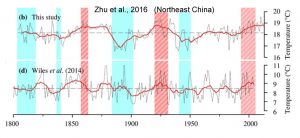
Rydval et al., 2016 (Scotland)
Hasholt et al., 2016 (Southeast Greenland)
We determined that temperatures for the ablation measurement periods in late July to early September were similar in both 1933 and the recent period [1990s – present], indicating that the temperature forcing of ablation within the early warm period and the present are similar.
